Princeton University Athletics
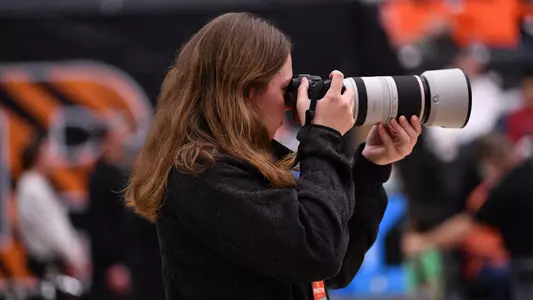
Feature Story: Photo By Kate Joyce
February 20, 2024 | Women's Track and Field
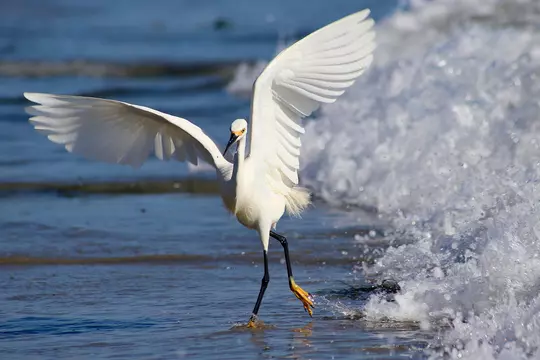
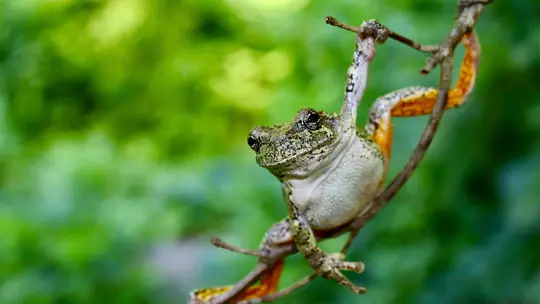
Part I – The Bird and the Frog
The bird is startled. The frog is just showing off.
They are separated by 3,000 miles, the bird in Southern California and the frog in Connecticut. Make no mistake, though. The bird is not happy. The frog is having a great time.
The bird is a snowy egret, and now both of its wings have shot up. There was probably a fish in its sights a split second earlier, and then in a blink a big wave crashes down. Saved, at least for the moment, the fish swims away, the hungry bird left to wonder how millions of years of instinct disappeared — along with lunch.
The bird now angrily strolls away from the ocean’s edge. It needs to regroup. There are, as everyone knows, other fish in the sea.
Still, the bird is angry with itself. And a bit embarrassed. Is the ocean supposed to startle a bird like this? Finally he takes a quick look around. Did this happen to any other egrets?
Then there’s the frog. Its left front leg is wrapped around a small branch. His right front leg hangs freely in front of him. Both of his hind legs are balanced on a slightly larger branch, and they’re spread as widely as they can be. The frog looks straight ahead, with a small smirk on its lips.
This is a gray treefrog, and a cocky one at that. The gray treefrog is supposed to be able to camouflage itself. You should be able to look at the tree and not see the frog at all. Instead, this one is posing, almost taunting the observer. Nothing scares this frog.
How is it possible to know all of this about a specific bird and a specific frog? Their pictures tell all. These pictures are more than photographs. They’ve crossed over into art. And like all great art, these photographs are open to whatever interpretation the observer imagines.
The artist who took the pictures is named Kate Joyce.
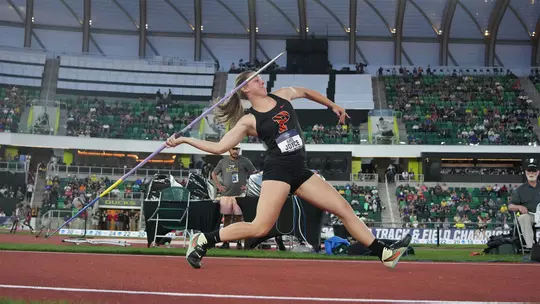
Part II – The Pitcher Turns Javelin Thrower
The little girl named Kate never wanted to play softball. From the time she was 3 or 4, her game was baseball. Actually, it’s more accurate to say baseball was one of her games. Growing up in Connecticut, there wasn’t a sport she didn’t like.
By the time she got to Weston High School, she was a volleyball player in the fall, a basketball player in the winter and a baseball player in the spring. Her position in baseball was pitcher. She always had a great arm.
She pitched all through Little League, which is not all that unheard of for a girl. When the pitcher’s mound moves back from 46 feet for 12-and-under to the regulation 60 feet, six inches for 13 and over, most girls switch to softball. Not Kate Joyce.
She kept striking out the boys throughout middle school and for her first two years of high school. By then, she was thinking of herself as a college basketball prospect, so she played some AAU ball in the spring and gave up on baseball.
“I wasn’t feeling baseball anymore,” she says. “I knew I wanted to be part of a spring team though. My gym teacher was also the girls’ track coach, and he told my father ‘she should try the javelin.’ He told me it had something of the same throwing motion as baseball. If I could pitch, I could throw the javelin. I figured I’d try it.”
And so she did. If you’ve ever watched the javelin in the Olympics, it looks very easy. If you’ve ever tried it yourself, it isn’t. For starters, it’s not nearly as heavy as you think. Also for starters, because of the way the javelin is designed, your first throw is likely to go straight up and come straight down. Why? Because you’re going to overthrow it and the tip won’t stay airborne.
“Everyone who picks up a javelin says ‘oh, this is so light,’” she says. “Then they throw it, and it goes nowhere. Or they hit themselves in the back of the head.”
Her experience was much different. Before her first attempt, she had never seen anyone throw a javelin. Not in person. Not on TV. Not in the Olympics. She was a junior in high school.
“I took a lot from a lot of sports,” she says. “From volleyball, I knew to stay on the same side on my follow through like in a volleyball swing. It’s a difficult event to learn. I didn’t know what to expect, but I had confidence in my arm.”
To call her a natural would be shortchanging her. By the end of that junior year — remember, this was her first experience ever with the javelin — she’d win the Connecticut state championship and the New England championship and then place third at the high school national meet, finishing just two inches behind the second-place finisher.
“Nationals was in North Carolina,” Joyce says. “I only went because one of my teammates was going, and I thought ‘Why not go for the experience? It could be fun.’ I didn’t go in thinking about the competition at all. They announced the finalists, and my teammate told me I was in second place at the time. Then I saw my name on the board, and I thought ‘no way.’ “
Actually, way. Of everyone there, she had to have the least amount of lifetime throws — and probably by a wide margin. So how did she pick it up so quickly?
“Kate had a number of great pitches in her arsenal that allowed her to play against boys for a very long time,” says Princeton head women’s track and field coach Michelle Eisenreich. “In short, Kate knows how to throw. Javelin technique can be very different from pitching, depending on how you were taught to throw the ball. Nevertheless, if you can throw, you can throw.”
In no time, Joyce went from baseball pitcher/college basketball prospect to one of the best high school javelin throwers in the country. What sort of jump would she make as a senior, when she’d had a full year of experience? None. Instead, a pandemic came along.
“The Covid year was a lot of waiting around to see if the season would be cancelled,” Joyce says. “Our coach would do Zoom meetings with the team, and we thought maybe we’d end up having a season. It was weird. I wasn’t doing anything sports-wise. I wasn’t used to that. I wanted to play basketball with a girl down the street, but we weren’t even allowed to do that. I worked out at home with my brothers. I went to the track with the javelin I had from school and worked out with my brothers. That was about it.”
The disappointment of a cancelled senior season was at least partly made better by the fact that she’d committed to Eisenreich and Princeton in the fall of her final year of high school. Eisenreich had seen one throw of hers as a junior, and that was enough.
“I was shocked by it,” Joyce says. “I wasn’t expecting that at all.”
Joyce would lose pretty much two straight years of competition, since her freshman year at Princeton was shortened to only a handful of events. This brought her into her sophomore year with very limited experience as a track and field athlete. The time away, though, did help her in an area that where she definitely needed it.
“It’s sort of the same throwing motion as pitching,” she says. “If you have a good arm for baseball, you could probably be good at it.”
You could be better at it if you actually know what you’re doing, though.
“Coach E said one of the best things about my throw was that it looked awful but I still could throw it far enough to get her attention,” Joyce says. “You need strength and speed, but you also need technique. One of my friends from home saw a picture of me from freshman year and said ‘I don’t think that’s right.’”
She had the right teacher in Eisenreich — “Coach E would love a team of just 50 javelin throwers,” Joyce says.
“When she arrived at Princeton, we got to work developing her javelin skills,” Eisenreich says. “This required her learning the difference between how she was generating power throwing a ball and how she must generate power to throw the javelin at an elite level, and that was a very difficult task. It was like saying that you learned to walk this way and you’ve been walking that way for 17 years but now do it differently. I think this speaks to her work ethic, ability to learn with an open mind and desire to be competitive.”
She was finally able to throw for real as a Princeton sophomore, and, after all that training, her performance was stunning.
First she won the Ivy League Heptagonal javelin throw while also adding the Most Outstanding Field Player trophy as well. Her mark of 51.96 meters set a Heps record, and she won the event by 2.34 meters over the second-place finisher. That’s nearly eight feet. The third-place finisher was 8.2 meters back. That’s just short of 27 feet.
Then it was off to the NCAA Regional, where she finished eighth, easily qualifying for the NCAA Championships. Once there, she finished sixth in Division I with another record-breaking throw of 54.68 meters — earning first-team All-American honors.
“First-team All-American?” she says. “I was not expecting that at all. I didn’t have high expectations. I remember my last throw. I was just going to run as fast as I could and chuck it as far as I could and hope my form stayed in place. I thought ‘just try that.’ And then it just kept going. When you’re on the runway, you can’t see how far it’s going. I thought “I think that’s far,’ but I was shocked. It was a PR [personal record] by three meters.”
She still had two more years at Princeton to compete, meaning an NCAA championship was a possibility. She qualified for the U.S. national championships. The 2024 Olympics were looming.
Her future was limitless. Or so it looked.
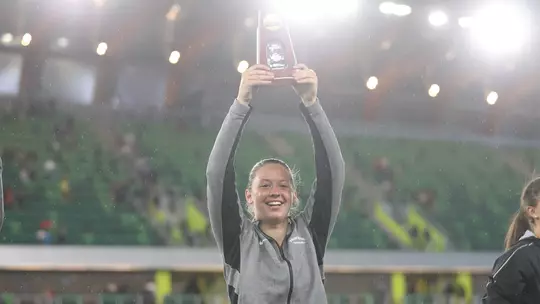
Part III – The Mangled UCL
Kate Joyce has just walked into the diner on Nassau Street, and, at first glance, Kate Joyce certainly looks the part of a national-, and possibly world-class, javelin thrower.As she says, the javelin is not an event where the only requirement is strength. Javelin throwers are nimble and coordinated, explosive and athletic.
She has eggs for breakfast, and she eats them slowly. In between bites, she talks about the event that she stumbled across, her coach, her experiences. She speaks quickly and smiles easily. She laughs a lot.
“Kate is a fierce competitor,” Eisenreich says, “but she can be but goofy at the same time. She is quick to crack a joke or devise a friendly prank on a teammate.”
That’s easy to picture. She certainly looks the part for that as well. It’s only when the subject changes that she begins to pick at her eggs, which she does as she talks about, of all things, the ulnar collateral ligament in her right elbow. She calls it by its abbreviation — the UCL.
What is the ulnar collateral ligament? The Cleveland Clinic website seems like a good place to get information:
“Your ulnar collateral ligament (UCL) is a strong band of tissue on the inner side of your elbow. It keeps your elbow joint stable during the act of throwing or overhead arm movements.”
Okay. Makes sense. What else?
“Stress on your UCL from repetitive overhead movement or a fall on your outstretched arm can irritate and inflame, stretch, partially tear or completely tear your UCL. Ligament damage leads to pain, looseness in your elbow joint and loss of function. The UCL is the most common ligament injured from repetitive overhand throwing. It’s probably best known as the ligament most often injured in baseball pitchers.”
The injury often requires surgery to heal it:
“If you have an unstable or torn UCL and nonsurgical treatments don’t provide pain relief or if you’re an athlete and want to continue throwing or engage in other strenuous overhead arm movements, your provider will recommend UCL reconstruction. With this surgery, your surgeon takes a tendon from another area of your body or a donor. The tendon is attached to the ulna and humerus to act as the new UCL. The remaining parts of the original UCL may be attached to the new graft to strengthen it. The goal of surgery is to restore elbow stability and range of motion, improve elbow strength and relieve pain.”
The surgery is commonly known as “Tommy John Surgery,” named for the baseball pitcher who was its first recipient and who made it famous.
The first sign that something was wrong for Joyce came during her freshman year, actually. At first, it was just some elbow pain. All she did was put a wrap on it, take some Advil and keep going.
“I didn’t think much of it,” she says. “Maybe it bugged me sometimes, but that was pretty much it.”
She felt better as a sophomore and into her junior year, which started out with some pretty significant goals. Among them? With her dual citizenship, she wanted to break the national record for Ireland of around 55 meters. She wanted to win the NCAA championship.
And then she went to compete at the North Carolina State Relays. As she warmed up, she knew something was wrong. She said an internal “oh no” and hoped it was nothing serious. It was only warmups, she told herself. Maybe when she did her full approach it would feel better.
As the spring went along, she pushed through the pain. And her results were solid, but hardly what they’d been the year before. She finished second at Heps. She was 22nd at the NCAA championships. Those finishes added up to second-team All-Ivy and honorable mention All-American.
Finally, after the season, she decided to see a doctor. A MRI was prescribed. The results?
“Mangled,” she says.
She actually chuckles as she says the word “mangeld.”
“One doctor said my UCL was completely mangled," she says. "When I got the MRI, I still wasn’t thinking it was too bad. I didn’t know what a torn UCL even meant. I read the results to the athletic trainer and asked what it meant, and he said ‘not good.’ I went to a few doctors, a few surgeons. They all said the same thing. It couldn’t be reattached, because there was nothing there left to attach.”
She underwent surgery in August 2023. Her version of the Tommy John surgery featured a ligament from her wrist that was moved to her elbow. Recovery would be 12-14 months. Her senior season, she knew, was gone.
Of course, it is important to note that, while she didn’t match her success of sophomore year, she did earn All-American honors in a major throwing event with a mangled UCL. Mangled? Maybe that’s more impressive?
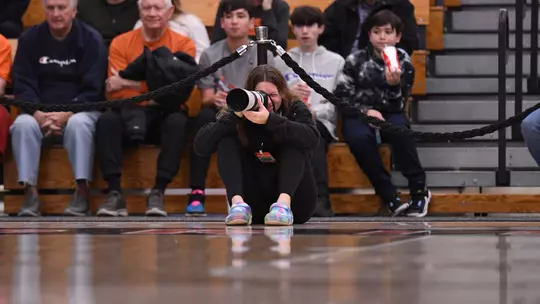
Part IV – The Photographer
Remember the gray treefrog? It’s Kate Joyce’s favorite animal.
“Definitely,” she says.
It’s not that she has a shortage of possible species to choose from in her hometown. The town of Weston is woodsy, and she has what she calls “a lot of critters” in her backyard, including a ton of gray treefrogs.
Why the gray treefrog? Maybe it’s a chicken and egg situation. Maybe the gray treefrog is her favorite animal. Or maybe the photo she took of one of them is just so good that it became her favorite.
“I took that one a while ago,” Joyce says. “It’s my coolest shot. I love how the limbs are all stretched out. That was in my backyard. It’s one of my desktop backgrounds.”
Remember the snowy egret? That shot was taken in San Diego. It’s her second favorite. It’s also made it to her desktop background.
“It can’t get away from the wave,” she says. “It didn’t see it until it was too late, and then it started to run away.”
The detail of the photos is incredible. The action. The color contrasts. They’ve been captured at the exact perfect moment. Clearly, this is not an accident.
“I’ve been doing photography since middle school,” Joyce says. “At first, it was mostly wildlife. I always found that pretty interesting. I’m mostly self-taught.”
Joyce’s residential college was Forbes, and she was one of two winners of the Dale Award, which is given to two sophomores in every res college. She was able to use the award to travel and expand her photography work.
She went from the NCAA championships in Oregon down to San Diego (where among other things she encountered the snowy egret). After battling illness, she went on to Montana, spending a day at Yellowstone — “if I knew what it was like there, I would have stayed for a month.”
From there, her next step was Puerto Rico. Or was it Acadia National Park in Maine? She did a lot of crisscrossing, and she eventually ended up at the Archbold Biological Station in Venus, Florida. By now she had a new camera, for which she saved for several years. She also had a UV camera that she got through Princeton to help her with her thesis work on Florida Scrub Jays.
“Males and females have different plumage that we can’t see,” she says. “I’m trying to see if the UV photography can pick it up. When I was doing thesis research, I met a photographer who shot for National Geographic. I was able to ask him for some tips, and the ones he gave me were really, really good ones. I’ve started to use as many as I can.”
Now, there’s something else to consider about being a javelin thrower. You don’t compete indoors. How could you? You’d throw it, and it would hit one of the walls of the building. Nope, this is strictly an outdoor event.
“I’ve always had FOMO when they compete indoors,” she says, again laughing.
So what do javelin throwers do during indoor season? In Joyce’s case, it was a chance to combine her love of photography and her love of being a great teammate.
“January and February are tough training months for javelin throwers.” Eisenreich says. “For any athlete, the routine and monotony of training is a challenge. Javelin throwers are no different; they train 50 weeks out of the year for six to eight competitions. What makes January and February especially difficult is that all their teammate are competing while they still have two months before their first meet.”
From her first day on campus, Joyce began to take pictures of her teammates.
“I’d spoken to her about her love of wildlife photography,” Eisenreich says. “Especially the frogs. Taking photos at indoor meets was a great way for Kate to be a part of the team even though she wouldn’t compete until the spring.”
“I’d always played sports,” Joyce says, “for as long as I can remember. This was my first time in an individual sport. I figured I’d take pictures. I did it so my teammates could have them.”
If Joyce was just a photographer, then she’d be looking for the best action shots she could get. Because she’s an artist, she is looking for her pictures to tell stories.
“One of my teammates won the indoor triple jump at Heps,” she says. “She definitely wasn’t expecting it, and she was in shock. When the 4x100 team won outdoor Heps, they weren’t expecting that at all. I feel like you have to have an eye for it. You need a sense of what’s going on around you and be ready for those moments. I love capturing the celebratory moments. I love getting a shot of two people on the sideline laughing who don’t know the camera is on them. What I’ve learned over the years, once you take your eye out of the camera, something could happen. You have to prepared and be in the right spot at all times.
Meanwhile, the diagnosis and surgery ended any hope that she would be able to compete during her senior year at Princeton. Her choices were to withdraw from school and come back in 2024-25 or stay enrolled, graduate and keep her eligibility to use somewhere else.
“I wanted to have my senior year with my friends,” she says. “I wanted to share it with them.”
Not many Princeton athletes have ever made as large an impact in as short a time as Joyce did. Now comfortable with her decision to stay enrolled, the next task was rehabbing.
“After the surgery, the first thing was to get a lot of rest,” she says. “Then I got to start the rehab process. At first, it was a lot of mobility stuff. My arm couldn’t move past 45 to 70 degrees, and I had to convince my body that it was okay to do so. I finally started to regain a full range of motion. After that, I slowly started to have more intense exercises.”
It wasn’t until the new year that she was able to start to do “very, very, very small throws.”
By this time, she’d already taken another step in her photography career, expanding it beyond track and field to any number of other Princeton sports. Her pictures have been used on goprincetontigers.com and the social media feeds for several teams.
“You can feel the emotions of a team when you’re really close to them,” she says. “When you’re there for a whole game, you can capture the moments, the expressions. It’s more than that, though. You can get an insight into what they’re feeling and doing. It makes you feel like you are a part of that team too. I’d never been to a hockey game before. When I shot women’s hockey, after every goal they scored, the way they came together, you could see they were having a really good time.”
As it turned out, so was she.
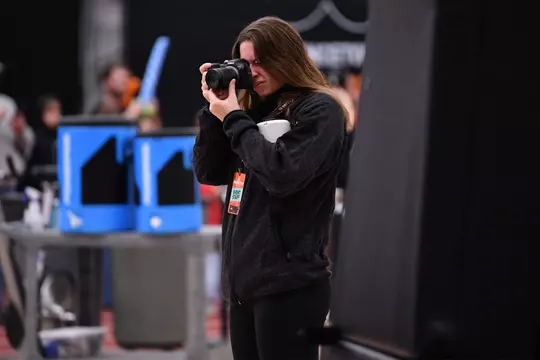
Part V – The Tattoo
With enough rehab and enough time, Kate Joyce is confident that she’ll be 100 percent, and actually even better. Had she not gotten hurt, she probably would already be throwing in the 58-60 meter range, which is Olympic standard level.
With her Irish citizenship, throws like that would have sent her to Paris for this summer’s Olympic Games. Instead, that dream has been put on hold until 2028. First, there is graduation from Princeton. Next year she’ll be back competing, this time as a Princeton alum at the University of North Carolina.
She told herself that she’d get a tattoo of the Olympic rings if she made the team. Her long-term goals still include that tattoo. Beyond that? She doesn’t know. She’s an ecology and evolutionary biology major, which usually suggests pre-med, but that is not in her plans.
“I was never interested in things that would make me money,” she says. “I think I’ll probably do pro track, which would mean traveling a bit, so I might as well take my camera along with me wherever I go. Photography would be cool.”
For now, you can find her, and her camera, at Princeton athletic events. At one recent men’s basketball game, she positioned herself on the baseline under the basket. She switched ends of the court. She went up into the stands to get an elevated view. She stood. She sat. She crossed her legs. She knelt.
When she's in her shooting position, her left eye squints. Her right eye stays alert, looking through the lens; her right index finger ready to fire. And fire again. And fire again.
It’s all in search of that moment, that one time when Kate Joyce does what not just anyone can do, which is to have a photograph tell an entire story, capture every emotion, create something that will endure. It's not easy. When it happens, you know you're looking at something special.
Just ask the treefrog and the snowy egret.
— by Jerry Price









